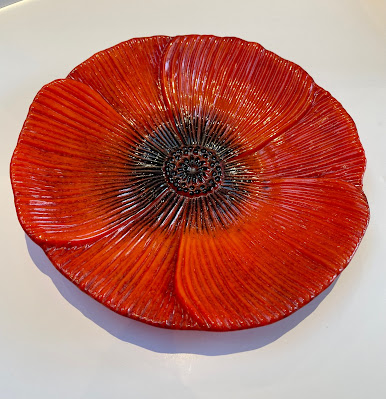The title may be a little confusing to some of you.........I can hear you thinking "how does she carve GLASS? Surely that is not possible?"
Well, you are right. glass is not wood, or stone. If I decided to go at a piece of glass with a hammer and chisel, I would end up with a pile of glass pieces and dangerous shards. But there is a way to "carve" into the glass....by using the kiln to do it!
There are different ways to "kiln carve" .“Kilncarving” is a term coined at Bullseye (manufacturers of art glass for glass fusing) to describe a kilnforming process that achieves a bas relief, textured, or sculpted look in glass. The process involves cutting a pattern or design in ceramic fiber paper, then stacking glass on top of the pattern and firing the piece in a kiln. During firing, the underside of the glass slowly softens and conforms to the ceramic fiber paper pattern, assuming its contours and textures. Here you see a "tree of life" pattern, the deep texture is at the back of the piece.
Alternatively, the same effects can be achieved by using a ceramic "texture tile", produced specially for this purpose. The tile needs to be treated with a "glass release" product, so that the piece lifts off easily after firing, and can then be formed into a bowl, or vase, if required, during a second firing.
The piece can be decorated...I added real gold detail to the tree of life, by fusing the decoration onto the piece before the slumping stage to give it a gentle curve:
I personally enjoy the look of textured glass, I believe the kiln-carving makes it look rather special. Unfortunately, I have badly shaky hands, so carving fibre paper is not on, I might end up minus a few tips of fingers!...........so I generally use texture tiles and I am grateful they exist! Here are some of the pieces I have made to date. I plan to try a vase next, with the lovely deep texture on the outside...watch this space!
 |
| I used rainbow iridised glass for this piece, the iridescent side sparkles in the light. |
Here is the other, smoother side:
Working with either your own designs cut from fibre, or a texture tile, bought or created yourself, will give you beautiful glass with an unusual look, and anyone who does not work with glass and kilns, will have no idea how you achieved this!
For further information about working with your own designs cut from fibre: click here
Jackie


















































